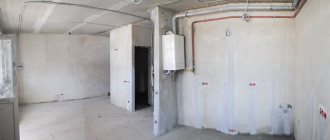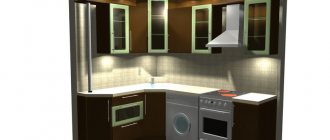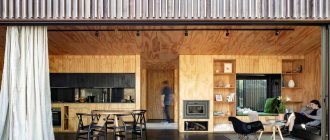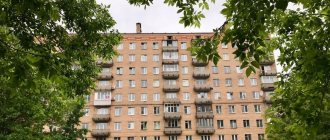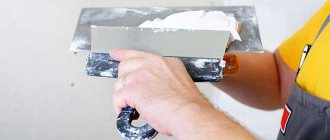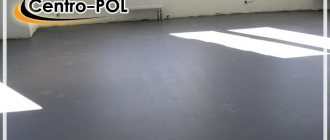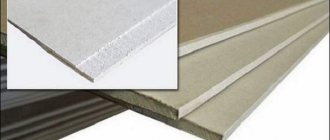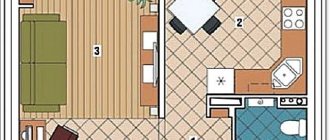When buying an apartment in a new building, you can choose from several finishing options. But sometimes the same name can mean different things, and therefore it’s easy to get confused. Our article will help you understand the types of finishes and understand whether one or another option is right for you.
Assistance in selling and purchasing real estate
More details
200-60-91
What should be done in the apartment when renting out the house?
There is no single answer to this question. Each developer may mean different things by roughing, pre-finishing and other types of finishing, since the names are not provided for by any regulations. Therefore, you should definitely read the project documentation and see what exactly the developer undertakes to do.
List of works that are considered necessary for the delivery of an apartment to the buyer:
- installation of an entrance door;
- supplying electrical wiring to the apartment and installing an electrical panel;
- heating distribution;
- waterproofing the kitchen and bathroom;
- window installation;
- glazing of the balcony (if this is permissible in this new building).
Protection of the rights of shareholders
Having reflected all the shortcomings in the defective act, you should keep one copy, and give the second copy to the developer; if he refuses to accept it against signature, send it by mail with acknowledgment of delivery. After this, the developer will have 45 days to eliminate all the defects specified in the defective act, or compensate for the cost of elimination if the shareholder eliminated them at his own expense.
If the shareholder refuses to accept the apartment and the developer agrees with such refusal, then the period for returning the money will also be 45 days.
Important. In accordance with Law No. 214-FZ, which regulates issues of shared participation in construction, a guarantee for an apartment for a period of 5 years also applies to interior decoration. This issue must be spelled out in the contract. For houses that are not covered by this law, the warranty period is 2 years. However, very often developers do not indicate warranty periods at all in the contract. Therefore, when concluding an agreement, you should pay attention to the presence of such a clause.
If a construction defect turns out to be hidden and was discovered only during the operation of the apartment, after the act was signed, in accordance with Law No. 214-FZ, it is necessary to contact the developer before the expiration of the warranty period with a written notification of the identification of defects. The developer is obliged to eliminate the defects at his own expense or compensate the costs of the shareholder who eliminated them independently.
If after your appeal the developer remains inactive, you can safely go to court. Shareholders who have decided to take such a step can be given some advice:
- Before going to court, collect as much evidence as possible indicating the developer’s unwillingness to correct defects in the work and, accordingly, to properly fulfill the contract.
- Submit all claims to the developer in writing and save correspondence.
- Invite expert builders to inspect the apartment;
- Record all defects in as much detail as possible.
There is no point in going to court without first preparing for this process; as judicial practice shows, most often the judge rejects the claim if the plaintiff’s demands are not supported by a convincing evidence base.
Without finishing (open plan)
An empty room in which only interior partitions are outlined, there are load-bearing walls and the set listed above. Everything else remains up to the buyer. Previously, such apartments were purchased quite actively, but now they are losing popularity.
The advantage of this type of finishing is the ability to carry out all the work yourself, without relying on the developer (sometimes the quality of what is offered leaves much to be desired). In addition, you can make the apartment the way you want. Another plus is that apartments without finishing, as a rule, are cheaper - on average by 15%.
However, saving on purchase does not mean reducing the cost of repairs: it can ultimately cost even more than finishing from the developer. In addition, the renovation will take additional time, and you will not be able to move into the apartment earlier than in 10 months, or even a year.
What types of finishing are there for apartments in new buildings in 2020?
types of finishing of apartments in new buildings
In advertisements for the sale of new apartments from developers, there are several definitions that characterize the degree of their readiness:
- fine finishing,
- rough finish,
- open plan, turnkey,
- pre-finishing,
- without finishing.
Let's analyze each of the options, after which you can choose the more preferable one for purchase.
How to understand what the developer is selling with finishing?
Finishing from the developer
Currently, there are no uniform finishing standards that construction companies must adhere to when delivering apartments. Even in one residential complex you can see several types of apartment renovations. Based on this, it would be correct not to focus on the title, but to carefully read the list of works for each object.
Advantages and disadvantages of each of them
What is called free planning, rough finishing and the “no finishing” option?
Construction organizations often combine the concepts “without finishing” and “rough finishing,” but sometimes there are still differences.
Rough finishing of apartments in new buildings
The “no finishing” option (pictured above) is the most ascetic of all. All communications are missing and only laid to the apartment. There is no electrical wiring, the current is supplied to the electrical panel, heating and water supply pipes are also not provided. The walls are not plastered, there are no interior partitions or floor screeds.
In fact, the apartment is a bare “box” in which double-glazed windows are installed and the entrance door is, as a rule, the most inexpensive.
What then is meant by “rough finishing”? Essentially, the same bare walls, but only with installed communications, heating, and often electrical wiring and installed meters.
With this option, the loggia is glazed, the bathroom is usually waterproofed, and the floor screed is poured. Options are possible with interior partitions: they can be completely absent, they can be partially installed (bathrooms), or they can all be installed according to the project.
The most uncertain type of finishing is “free layout” . When the developer specifies this option, it is important to understand that the finishing can be either “pre-finishing” or “rough”, but interior partitions are not provided here.
Let's conditionally combine all the considered options into one group “without finishing” to make it easier to evaluate the “pros” and “cons” of purchasing such apartments. However, it should be remembered that different equipment and the totality of work performed have a significant impact on further repair costs.
So, the advantages of apartments without finishing
1. Generally lower cost.
Apartments of the same category, but “without finishing” will be 20-30 percent cheaper than apartments “with finishing”. However, the seller may not set such a price difference if he believes that due to its characteristics they will be sold at a higher price.
For example, a residential complex has a good layout, territorial location, or is an exclusive offer on the market.
2. Possibility to move into an apartment in a shorter time.
Some developers allow owners to make repairs even before putting the house into operation. Therefore, if you manage quickly, you can be one of the first to move into the apartment.
The remaining residents will be forced to wait (up to six months) until the renovation of the entire house is completed, and this may take several months. You will receive the keys, if not in advance (not all companies do this), then immediately after the commission accepts the house.
3. It is very important that you can make repairs to your taste.
You personally choose and create the space where you will live. What style will the design be in, what construction and finishing materials to use, and also choose a convenient layout.
You can solve all these problems yourself or hire a designer and the necessary professionals.
4. Identification of violations committed during construction.
In an apartment “without finishing” you can immediately see all the cracks, gaps, as well as wet walls that would be hidden under materials in an apartment “with finishing” and discovered only after some time. It is optimal to buy a “box” in a house that has already been rented out and has stood for at least one winter season.
6. Real savings on repairs.
If you do not yet have the opportunity to carry out a full renovation, then you can prepare an apartment for living quite inexpensively. Lay affordable linoleum on the floor (if there is a screed), paint the walls and ceiling, and install plumbing fixtures (if there are pipes).
If you purchased a completely empty premises, then you will have to invest at least 10–15 percent of its cost in repairs.
Now let’s look at the main negative aspects of purchasing a home “without finishing”
- Not comfortable living conditions.
Loud sounds, debris, construction dust - all this will accompany you, since the neighbors will be engaged in repair and installation work for at least another year, or even two. It is good if at this time the premises in the entrance are not damaged, because in this case the developer usually declines all responsibility and repairs will fall on the shoulders of the residents.
- Actual costs turn out to be much higher than planned.
When you first create an estimate, you expect to spend a certain amount. But life makes its own adjustments: the cost of materials at retail and their required volume, wages for specialists and workers, as a rule, do not coincide with your calculations .
In addition to this, there are always unforeseen costs, and sometimes, unfortunately, something has to be corrected. Customers purchase everything at wholesale prices and hire proven performers. Obviously, the cost of finishing will not increase after the contract is signed.
- Physical and nervous overload
The entire cycle of repair work falls on your shoulders. Purchasing materials, coordinating documents in various authorities, searching for performers, as well as further quality control of work, and possibly independent work, is what you will have to deal with. As a rule, all this is done without interruption from the main professional activity, which leads to fatigue and possibly conflicts in the family.
- Increased repair time.
Few people can immediately soberly assess the timing of repair work. You need to understand that you need to spend from six to ten months on a good repair. Often you don’t meet the schedule, even if you hire specialists, because there is a need for additional purchases, new work or rework, which means additional expenses.
- There is a danger of performing repairs of inadequate quality.
Unfortunately, if you are not an expert, it will be difficult to avoid mistakes and take into account every detail. It is not a fact that you will be lucky with workers.
The developer is obliged to eliminate the identified shortcomings, so he has an interest in ensuring that everything is completed without any complaints.
- Possibility of damage to the finish due to the shrinkage process of the house.
This point is especially important for brick houses, the structures of which are subject to internal deformation in the first three years.
Wallpaper may fall off, ceramic tiles may crack, and cracks may appear.
What conclusions can be drawn about buying an apartment without finishing?
Apartments “without finishing” can be recommended to those who are ready for financial and emotional stress in order to acquire an apartment made at their discretion and to their taste. Still, it’s better not to completely rely on yourself and turn to specialists, for example, a designer.
What is "White Box" or pre-finish?
White Box finishing or pre-finishing
What does this type of finishing include? The apartment has been completely roughed up, there is a screed on the floor, the ceiling and walls have been leveled and then puttied. The room has all communications, radiators have been installed everywhere. As a rule, the loggias are generally glazed to the same standard throughout the entire house, and the apartment is equipped with a metal door.
As a rule, the loggias are generally glazed to the same standard throughout the entire house, and the apartment is equipped with a metal door. The person who purchased the apartment will not have much work to do: choose interior doors and install them, decide on the type of flooring in the rooms, lay tiles, stick wallpaper, and also invite craftsmen to mount the ceiling.
Sometimes apartments are offered without interior partitions, which is an excellent solution for those who value individual projects.
Attractive aspects of pre-finished apartments (White Box)
- Availability and relative ease of repair. It is much easier to create an estimate for work and materials, as well as estimate the required time to prepare the apartment for occupancy.
- Attractive price.
The price per square meter of an apartment with White Box finishing is lower than with full finishing . It is important that only final repairs are needed, and the difference in cost ranges from 7 to 15 percent compared to an apartment “without finishing”.
- Possibility to decorate an apartment taking into account personal preferences. Plan the size of the premises yourself and agree on the location (apartment without installed partitions), use various finishing materials and much more that suits you.
- It is easy to determine the true level of finish. Pre-finishing will highlight flaws and demonstrate the merits of work already completed. In this version, with white walls, the apartment looks very advantageous.
- Moderate amount of construction debris and dirt.
The main “grand” work is behind us, which means the apartment and the adjacent area (entrance, elevator) will be much cleaner and more comfortable.
- Higher quality of construction of the house as a whole.
Initially, “White Box” level finishing was introduced during the construction of luxury real estate . Nowadays it is common in all classes, but it still often means that the rest of the decoration of the house (facades, staircases, halls), as well as the landscaping of the local area, are performed at a high level. This means that living in such a house or residential complex will be comfortable.
Negative aspects of apartments with pre-finishing finishing
- Worries about repairs and costs are much less than when purchasing a home “without finishing,” but there is still a risk of repairs with imperfections. You may also fail to meet the required deadlines or end up with a damaged repair due to shrinkage of the building.
- An apartment with such finishing is still in a new building. Therefore, no one will protect you from the noise and dust in the entrance when your neighbors are renovating their apartments or transporting things.
What conclusions can you draw about buying an apartment with White Box finishing?
The White Box finish will be of interest to those who want to choose the style of the apartment and the materials to implement it. But at the same time, I am not ready for too large and costly a volume of work. Due to the lack of investment in rough work, you can get real benefits, which will be up to 30 percent of the total costs . However, the apartment owner still needs to carry out repairs, independently or with the help of hired workers.
Rough finish
Some developers consider this option to be basic, so often the concepts of “apartment without finishing” and “apartment with rough finishing” mean the same thing - however, there is still a difference between them. In addition to the required minimum, the walls are leveled, which facilitates repair work, and heating radiators are installed. The walls can be plastered and the floor screeded. In addition, the front door here is of better quality than in unfinished apartments.
The advantages of such housing are savings on some construction work. The price of apartments with rough finishing will also be lower. In addition, you still have the freedom to choose many details and carry out construction work.
The disadvantages are identical to apartments without finishing: you will not be able to immediately move into the purchased housing, you will first have to spend time and money on repairs. However, compared to the previous option, the costs will be less.
Developer's responsibility
When concluding an agreement providing for participation in shared construction, you should be aware that the developer, accepting the fulfillment of obligations to carry out construction, bears responsibility in accordance with the law and the agreement. If the developer violates its obligations under the contract, the shareholder may use the following civil measures against the developer:
- Terminate the contract (Article 9 of Law No. 214-FZ), as a result of which the developer will be obliged to return the money to the shareholder with interest, taking into account the refinancing rate of the Central Bank. The contract will be considered terminated from the moment when the corresponding notice of unilateral refusal to fulfill the contract is sent to the developer.
- Collect a penalty (Article 6 of Law No. 214-FZ). In addition to the requirements of the law, a contract may provide for a penalty. In this case, the contract can only increase the penalty provided for by law. If the terms of the contract reduce it, they are illegal and can be challenged in court.
- Collect damages. Several legal acts provide this right to the shareholder: Civil Code (Article 15), Law No. 214-FZ (Article 10), Law No. 2300-1 (Article 28). The shareholder's losses are understood, for example, as the cost of renting housing for the period the developer eliminates construction defects. The shareholder can demand damages simultaneously with the collection of the penalty.
- Compensate for moral damage (Law No. 2300 -1 Art. 15). Its size is determined in each specific case individually. The nature and degree of moral and physical suffering must be proven by the shareholder.
- Compensate for legal expenses (Article 98 of the Code of Civil Procedure) All expenses incurred by the shareholder in connection with the appeal to the court, provided that the claim is satisfied, can be recovered from the developer.
In addition, it is possible to bring an unscrupulous developer to administrative and criminal liability. State supervision in the field of shared-equity construction is authorized to be carried out by the bodies of Rospotrebnadzor, since this area of legal relations is covered by legislation on the protection of consumer rights, and by executive authorities.
Having understood the rules for accepting an apartment and having studied the rights guaranteed by law, you will definitely be able to become the owner of quality housing and nothing will overshadow your joy from your housewarming. And in the event of a dispute with the developer, you will have the opportunity to legally demand compensation for upcoming material costs, as well as moral damage caused by the actions of the developer.
Pre-finishing
This finishing option is often equated to rough - and the difference between them is really small. In pre-finished apartments, the floors have been screeded, the walls have been plastered, pipes, risers and plumbing connection points have been installed, and the electrical network (including sockets and switches) is ready for use. The owner only has to install the plumbing and carry out cosmetic repairs: the surfaces are already ready for final finishing. Such apartments are also called “white box” or “white box”.
Pre-finished apartments are some of the most popular on the market, and for good reason. They cost 5% lower than apartments that have already been renovated, and the cost of completing the work will be minimal. The repair will also take less time: in the most favorable case, only a month or a month and a half.
The disadvantages of this option depend on the developer. Sometimes the quality of the work performed and finishing materials may be unsatisfactory. However, it is worth keeping one nuance in mind: new houses, especially panel houses, are subject to shrinkage, so inexpensive finishing materials may be suitable for temporary repairs; after 4-5 years it will be possible to carry out full and high-quality repairs.
Checking ceilings, floors and walls
Of course, if you take a good look at the surfaces of the walls, you can see certain imperfections even under the wallpaper. However, you should not trust solely your eyes, and in the process of accepting an apartment from a developer with finishing, you must:
- Determine the level and evenness of the walls using a plumb line;
- The height of the ceilings in each room should be measured. This is done using a tape measure, and it is important to remember that the permissible difference in the heights of different rooms should not exceed 5 mm;
- A laser level will be useful for measuring the plane of floor and ceiling structures.
Finishing walls, floors and ceilings in a new building
You should also carefully examine the quality of laying materials:
- Wallpaper must be hung in accordance with the pattern. Bubbles and folds should not appear;
- The tiles must be tightly fitted to one another, and the resulting seams must be carefully rubbed. If there is a drawing, it must also be respected;
- In no case should there be smudges or various stains on painted walls, but only an even, dense layer of paint.
Advice! In order to determine how well the tiles have been laid, knock on them. This way you can determine where the voids are.
You should also check the quality of the floor installation. You can do this as follows:
- Walk along the entire perimeter of the floors; they should not creak;
- If linoleum was used, all its joints must be carefully sealed;
- In the case of parquet boards or laminate, you should pay attention to the tight fit of the boards to each other. Only a small indentation at the wall is allowed so that no damage occurs during expansion;
- Check the entire surface of the floors, there should not be any bulges;
- There should be securely fastened baseboards around the entire perimeter;
- There are small thresholds between all rooms.
Among other things, you should carefully inspect the ceilings; there should be no leaks, visible voids or incorrect joints of the slabs. The fact is that if during the process of accepting an apartment you cannot detect existing problems, you will subsequently have to spend a considerable amount of money on correcting them yourself.
Finishing
This apartment has everything except furniture: the walls are covered with wallpaper and tiled, there is a ceiling and floor covering (usually linoleum, less often laminate), interior doors and plumbing are installed, and sometimes a gas stove. All communications and electricity are also available. The price of such an apartment is not necessarily higher: it depends on the area, location and other factors.
Such apartments have a definite advantage - you can move in without delay, all you have to do is bring in the furniture. If you are urgently looking for new housing, then an apartment with a fine finish will be perfect for you. In addition, you will avoid repair costs. This property is perfect for renting out.
However, it also has disadvantages. Developers usually use the most economical materials, and the quality sometimes leaves much to be desired. In this case, you have to dismantle all the finishing and carry out the work yourself - which, of course, will result in unnecessary costs and loss of time. In addition, the house may shrink, which will also require repeated repairs after a few years.
If you bought an apartment without finishing, where to start the renovation?
Before you start renovating an apartment without finishing, clearly decide how it should look. Make a detailed layout indicating the location and size of all rooms. After this, select a suitable finish for each room, decide on the necessary materials, their quantity, and application method. This project will become your basis for drawing up an estimate - the most important document that takes into account absolutely everything, even the most minor work and remuneration of the construction team.
Please note that the initial estimate does not always coincide with the final estimate. This usually occurs due to replacement of building materials and the need for additional work. That is why the estimate immediately includes an increase in cost of approximately 15–20%. It is quite difficult to independently renovate an apartment that has no finishing. You will have to perform a significant amount of work that requires special skills. In this situation, it is impossible to do without the involvement of specialists.
The renovation of an apartment without finishing takes place in two stages. The first is rough finishing, and the second is finishing. Rough finishing, as we have already found out, represents preparatory work: dismantling, laying electrical wiring, laying out pipelines, cables for communications. Such actions are also divided into several stages. This makes it easier to plan the purchase of raw materials and coordinate the execution of work with the craftsmen. In addition, this approach will allow you to spend money rationally. Most often, renovations start from the back room and are carried out from top to bottom.
Turnkey finishing
This option is very similar to fine finishing (and sometimes these names are also combined) - unless the developer provides additional options. In business and premium class apartments, a special interior is created according to a design project: not only plumbing fixtures can be installed, but also household appliances (for example, in the kitchen), as well as furniture. The choice of options available in a turnkey apartment depends on the developer, so it is extremely important to study the project documentation.
You can move into such an apartment right away - especially if not only cosmetic repairs have been made, but also the necessary equipment and furniture have been installed. In addition, in luxury complexes you can choose your own design project: this is how developers provide an individual approach to clients. Repair costs are thus completely eliminated.
The main disadvantage of turnkey apartments, of course, is their high price. They are mainly popular in the premium market because design projects and installation of all the necessary equipment are expensive for the developer - and subsequently for the buyer. Therefore, not everyone can afford such housing. In addition, the developer will not be able to satisfy absolutely all your wishes, so the “finished” interior can sometimes be uncomfortable.
The vicissitudes of repair
At whatever stage you buy an apartment (except for the option with a complete renovation), you will have to decide on finishing issues yourself. When it comes to rough finishing, few people can handle this on their own.
There is a lot of work to be done in such an apartment.
You have to hire workers - and here questions may arise related to the fact that contractors sometimes perceive the concept of “rough repairs” completely differently, and the list of works included in it can vary significantly among them.
List of works in a new building
Sometimes their list does not cover everything that needs to be done in your case, so what is not included will have to be paid separately. Sometimes it is easier to agree on a price per 1 m2 of apartment area, and you yourself will determine the list of necessary work.
Sample contract
So that this is not unfounded and assumes the contractor’s responsibility for the quality of the work performed, it is necessary to conclude a contract agreement, which will detail everything that you have agreed upon and stipulate the terms of the work. What their list might be, read on.
Find out where to start the repair, and also familiarize yourself with the main stages of the work in a special article on our portal.
Video - Pre-finishing from the developer
The procedure and nuances of performing work
So, you have decided on the list of work, and if you do not do it yourself, then in any case, hired workers should be controlled. Let’s look at what should be done and in what order – including if repairs are being carried out in a newly built private house:
| Type of repair work | A comment |
| The delimitation of internal space by partitions is carried out according to a ready-made plan, which you, as the customer, must provide. Among other things, you must decide whether these partitions will be solid or decorative. If these are permanent partitions, you need to decide what masonry material to use. To install plasterboard, glass or wooden structures, you will need specialists of a different profile. |
| At the next stage, the floors throughout the apartment must be leveled. You need to pay special attention to this, since differences in marks can be significant, and if the thickness is more than 2 cm, the screed needs to be reinforced. For this purpose, you can use fiberglass mesh, or you can simply reinforce the cement mortar with fiber (or buy a dry reinforced mixture). |
| Take care immediately of waterproofing the bathroom – especially if you plan to install a shower with a drain instead of a bathtub. Ceramics, of course, is a sealed material, but there are also seams that can become saturated with water. Modern waterproofing materials can make the floor completely waterproof, and you will never return to this issue again. |
| In apartments, wiring is often done along the ceiling, so this work begins after pouring the floor. The electrical part of the work includes: 1. Wiring in rooms; 2. Installation of the switchboard and connection of wiring to it; 3.Drawing low-current wires in boxes for telephone, cable or antenna TV, Internet; 4. Installation of distribution boxes and socket boxes (switches and sockets themselves are installed last). Note: You must provide the electricians with a wiring plan in advance, which will indicate the installation locations of sockets, switches and lighting fixtures. Alternatively, a contractor can make calculations and make drawings, but you need to clarify at whose expense this work will be performed. It must be treated with all responsibility, since redoing anything electrically will subsequently be problematic. |
| The plastering part of the work is carried out after the electrical part, since wiring in apartments is almost always carried out in a closed way, and this makes it possible to repair fines. In the contract, specify what maximum deviations in the screed are permissible, so that later you don’t have to argue and prove anything about this. Note: If the ceiling is plaster, then you need to tackle it first, and then the walls. But today, more and more often, people give preference to suspended structures, and they are installed after the completion of wet and dusty work. |
| After leveling the walls - and if they are tiled, then after its installation, you can begin installing a suspended or stretch ceiling. If it has a complex design and there is a project in which lighting has been worked out, electricians can complete the required wiring for devices in advance. Otherwise, they simply leave the outlet under the central chandelier. Note: In general, wires can interfere with the installation of the frame, so the ceiling installers themselves install them under the lamps after all the load-bearing elements of the subsystem are in place. |
| The water pipes in the bathrooms are also installed after the walls are leveled. The only thing you can do is not make any fastenings yet, so that the clamps do not interfere with laying the tiles. |
| Ceramic tiles today are so popular and varied in design that they are often used not only in bathrooms and kitchens, but also often in rooms. They begin to install it on the walls after the ceiling work is completed, but before the finished floor is completed. |
| Upon completion of all wet and dirty work (not counting painting), you can begin lining the openings. This includes the installation of door frames (leaves and trim will be hung later), and cladding with tiles, stone, installation of portals and arches. These works are not included in the list of mandatory ones; they are usually offered to the customer as additional. |
| If you plan to glaze and insulate a balcony, you must do all the work before finishing is done in the room through which you enter it. This can also be done by your contractor, but for a separately agreed amount. |
| The sequence of decorative coatings is selected based on the materials and technologies used. The main principle is that when doing new work, do not spoil what has already been done. This is especially true for painting. The order of its production should be as follows: first paint the ceiling, then the walls, and only after that lay the floor coverings. If there is wallpaper on the walls, and there are tiles on the floor that can be laid - or, at worst, washed, the wallpaper can be glued afterwards. Please note! Priming, which must be carried out both during the application of plaster and on top of it before painting work, can either be included in their cost or carried out by the contractor for a separate fee. |
| Another type of “options” that you may be offered additionally is insulation work. You may need them: 1. On the ceiling, if the apartment is on the top floor and it is not heated; 2.On the external walls, if the apartment is corner and on the leeward side; 3. On the floor, if the floor is the first, and below it is a cold technical basement. |
| In modern housing construction, heated floors are no longer a sign of elite apartments. They are almost always designed in cottages, and often in apartment buildings. But even if the developer did not provide for underfloor heating, you can take care of installing it in the bathroom, hallway or nursery yourself. In order to choose the right heating elements and their installation technology, you must decide in advance on the type of decorative floor covering. |
| The last thing on the list of finishing works is usually the installation of flooring. This item is mandatory, but the cost of work varies greatly depending on the type of material and the complexity of its installation. Many types of flooring materials (carpet, linoleum, laminate), provided the base is well prepared, can be laid independently. |
Prices for various types of screeds and self-leveling floors
Screeds and self-leveling floors
New building class and finishing option
The level of surface treatment and finishing depends on the class of the new building. As a rule, panel houses of standard projects in the standard category are delivered without finishing or in a rough state. The comfort category can be sold in a pre-finished version - about the difference between comfort and economy class of new buildings .
The draft version with installed partitions, supplied pipes and wiring is better from the buyer’s point of view - you do not have to take on large-scale improvements that the developer could well have done. But the quality of work can be different, so you should only accept housing with a specialist and be very meticulous!
In the business class, premium segment and luxury houses with an open plan, apartments can be sold both without surface preparation at all and in turnkey condition according to the proposed design project.

